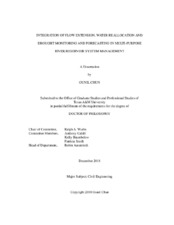| dc.contributor.advisor | Wurbs, Ralph A. | |
| dc.creator | Chun, Gunil | |
| dc.date.accessioned | 2019-01-23T16:31:56Z | |
| dc.date.available | 2019-01-23T16:31:56Z | |
| dc.date.created | 2018-12 | |
| dc.date.issued | 2018-10-17 | |
| dc.date.submitted | December 2018 | |
| dc.identifier.uri | https://hdl.handle.net/1969.1/174325 | |
| dc.description.abstract | Population and economic growth have contributed to increasing water uses while available water resources are limited. Recently, the occurrence and damage of drought are increasing worldwide due to the impact of climate change. The effective water management requires for assessment on the current and future water availability based on a water allocation strategy, scenarios, and updating hydrological condition.
The extension of hydrologic period-of-analysis for the Texas WAM/WRAP System increases the model capability. A new water allocation strategy based on Texas WRAP/WAM water priority system is established for water management in Korea. Groundwater drought monitoring and forecasting methodology in Korea was developed based on correlation between groundwater level observation data and precipitation data using Artificial Neural Network model. The research consists of the following tasks:
• The original sequences of Brazos WAM input dataset has a 1940-1997 hydrologic period-of-analysis. The methodology developed in this research is to update and extend hydrologic sequences of input datasets to present using precipitation and evaporation maintained by TWDB. This approach is much easier to implement and is particularly advantageous in situations where accurate data required to adjust observed flows are unavailable or difficult to compile or stream gaging station have been discontinued.
• Korea has no water right system considering priority of each water right. The research included developing a water allocation strategy in Korea based on two alternative schemes. A priority-based long-term water allocation strategy was developed for national scale water management and planning. A water allocation strategy for relatively short-term water availability study for drought management is established based on reallocating water supply to hydropower dam and reducing some portions of water supplies.
• The groundwater drought monitoring and forecasting methodology was developed to support the Drought Early Warning System in Korea. The methodology is based on Standardized Groundwater level Index (SGI). The SGIs for 256 monitoring sites were converted into the area SGI for 167 cities nationwide. The groundwater drought forecasting method was developed based on the correlation between SPI and SGI. The correlation model was employed NARX Neural Network Model. The groundwater drought forecasting was conducted with the correlation model and SPI forecasts. | en |
| dc.format.mimetype | application/pdf | |
| dc.language.iso | en | |
| dc.subject | WRAP/WAM | en |
| dc.subject | drought | en |
| dc.title | Integration of Flow Extension, Water Reallocation and Drought Monitoring and Forecasting in Multi-Purpose River/Reservoir System Management | en |
| dc.type | Thesis | en |
| thesis.degree.department | Civil Engineering | en |
| thesis.degree.discipline | Civil Engineering | en |
| thesis.degree.grantor | Texas A & M University | en |
| thesis.degree.name | Doctor of Philosophy | en |
| thesis.degree.level | Doctoral | en |
| dc.contributor.committeeMember | Cahill, Anthony | |
| dc.contributor.committeeMember | Brumbelow, Kelly | |
| dc.contributor.committeeMember | Smith, Patricia | |
| dc.type.material | text | en |
| dc.date.updated | 2019-01-23T16:31:57Z | |
| local.etdauthor.orcid | 0000-0002-8489-4229 | |


